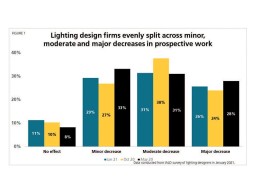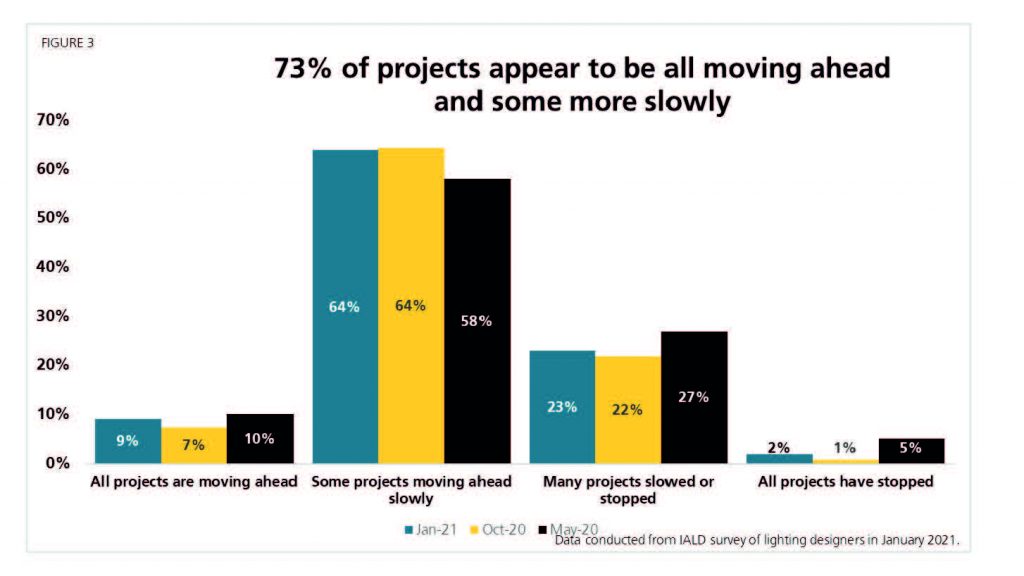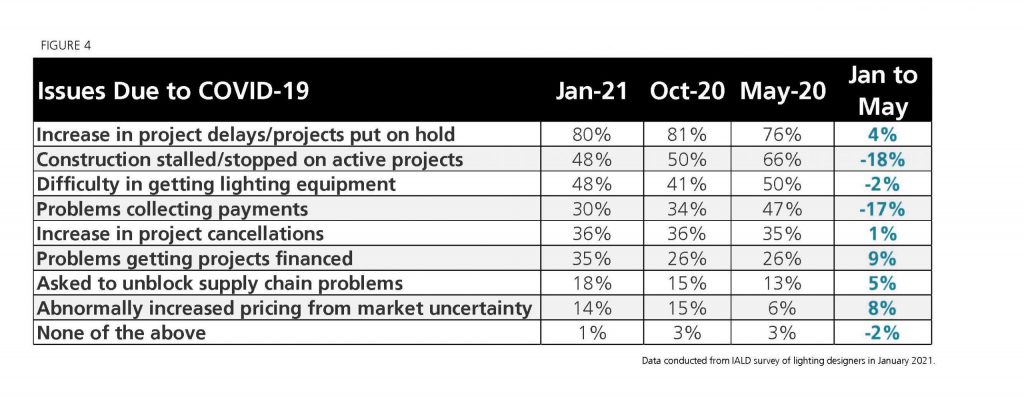
One Year On: Impacts of Covid-19 on the lighting design industry
Throughout the Covid-19 crisis, the IALD has carried out regular surveys of the lighting design profession to see how it continues to be affected by the global pandemic. Here, they present their most recent findings.
As the Covid-19 crisis extends into 2021, lighting design firms continue to experience ongoing challenges as the economy continues to react to the global reach of the pandemic. While vaccines are being distributed and administered, rollouts globally have been slower than many had hoped. Lighting design firms and lighting designers have experienced a variety of effects from this pandemic based upon size, geographic location, and distribution of work across different sectors.
To better understand these challenges and gain insight into the pandemic’s ongoing impact, the IALD surveyed lighting design business owners and principals about the Covid-19 crisis in May 2020 and October 2020. This survey was repeated at the beginning of 2021, opening on 14 January and closing on 29 January, and posed questions for the January to March 2021 time frame. A total of 342 lighting designers, representing 46 countries, responded to the most recent survey. Lighting design firm sizes ranged from solo practitioners (22%); two to five employees (27%), six to ten employees (18%), 11 to 49 employees (25%); and 50+ employees (8%).
Lighting Design Firms Still Resilient
In May 2020, when the IALD first surveyed lighting designers, the results indicated that most lighting design firms were not fully prepared for this crisis – not unlike many other businesses worldwide. Though the majority of the respondents from this time did not have a business continuity plan in place when the Covid-19 pandemic started, almost 30% of respondents did. While many of us were hoping for 2021 to start off strong, the ongoing pandemic damped any strong recoveries. In 2021, survey results indicate that less than 10% of firms reported no negative effect from the pandemic, and most firms are largely maintaining the status quo since the October 2020 survey.

The full impact of the global pandemic remains unknown. In May last year, most firm owners (54%) anticipated it would take between one to three or more years before businesses return to pre-Covid-19 levels. In October, many lighting designers shifted the narrative from when business returns to normal to how the lighting design profession will look in the future. And in January 2021, many lighting designers recognised that the built environment will shift and there will be changes in how business is conducted.
Lighting Design Firms Maintain Status Quo
Lighting design firms around the world continue to experience a range of effects on prospective work. While only a small portion of owners and principals (8%) have not experienced any negative effect on prospective work, most firms seem split among a minor decrease (29%), a moderate decrease (31%) and a major decrease (26%) in prospective projects.
Solo practitioners seem to have been hit the hardest and were among the largest segment of those who cited a major decrease (26%) in prospective work. Firms with two to five employees were even split among minor, moderate, and major decreases. We start to see less negative impact – more moderate and minor impact – on prospective work as the firms (11 to 49 and 50+) increase in size.
Lighting design firm owners’ and principals’ confidence in getting new proposals and signed contracts in the months of January to March 2021 is much higher (approximately 20%) from the first survey in May 2020. While we still see an increase from October 2020 to January 2021, this minor increase equates 8% greater chance of getting new proposals and only 2% increase for signed contracts for January to March 2021. This means that optimism has increased slightly since the end of 2020.
Despite the minor anticipated increase in new proposals, lighting design firms predict an increase in revenue losses, up 6% from 32% in October 2020 to 38% in January 2021. This indicates a slight downturn in revenue for the beginning months of this year.
No Change In Breadth of Sectors Affected
Many sectors in which the lighting design community works have been affected by Covid-19, with some experiencing growth and others showing a decrease in activity. The sectors that are showing the most promise have not changed since the last survey. Increases are in the following sectors: residential (41%), public/government (20%), and health (19%).

As with the last survey, the same sectors that have been hit hard are more public facing like hotel (59%), retail (58%) and amusement and recreation (55%). With a portion of the workforce still working from home, the office sector has also seen a strong decrease (48%).
However, most current projects (73%) are either moving ahead as normal, or at a slightly slower pace. The January 2021 survey shows little change since the October 2020 survey. January 2021 shows a slight increase in slowed or stopped projects compared to October 2020.

Top Covid-19 Related Issues the Same
Since May 2020, the top three issues have remained the same for lighting design firms, but their severity has decreased indicating that things are looking more optimistic. These three issues are: increases in project delays/projects on hold; stalled or stopped construction on projects; and difficulties in getting lighting equipment. Owners or principals are seeing fewer issues with stalled projects and collecting payments since May 2020. There have also been increases in projects getting financed and abnormally high prices due to market uncertainty. However, neither of those issues are in the top three issues reported.

When Covid-19 first hit, most firms (71%) put a freeze on major expenditures. Freezes on major expenditures dropped from 71% in May 2020 to 46% in January 2021. 60% of firms in May placed a hold on discretionary spending compared to 48% in January 2021. Hiring has also softened indicating that 62% of firms are open to new hires.
The Positives for Lighting Designers
While many lighting designers have a range of thoughts from positive to negative about the impacts of the pandemic on the lighting design profession, we also know that many lighting designers have seen positives outcomes as well.
Overwhelmingly, lighting designers and teams cited that they can effectively work remotely and be productive. There were threads from lighting designers about how remote work allows for greater freedom and flexibility. One respondent shared that as remote work became more acceptable, there was more empathy for designers who had to juggle work and family responsibilities and demands. Another respondent shared that working remotely has changed the perception about being open to different working hours to accommodate personal schedules. One lighting designer happily shared: “I can maintain the calibre of work by working from home and I am still keeping my clients happy. I love the flexibility of working from home.”
A second theme that emerged from working remotely is that many lighting designers agreed that remote work cut down on unnecessary travel and expenses. This was especially true for lighting designers who travel internationally for client meetings and projects. One designer was relieved and shared that working from home was very efficient and saved a lot of travel time: “With more international projects this is a huge relief.”
Lighting designers have had more time to reflect on how the pandemic has affected them and their colleagues. One designer shared that the pandemic showed them that their company really cares about their employees. The staff had become closer on a personal level, and this has increased the strength of the team. A business owner shared that the pandemic gave them the opportunity to learn more about their employees and themselves. They already knew that they were able to operate remotely, and what they didn’t know they figured out. One designer said they learned about humility – how important “the in-between” is on all levels, adding that many high-end architects have “let their guard down” and become more “human.”
The pandemic also opened new business possibilities. Less travel allowed for some firms to focus more time and energy on strategic thinking and planning. From diversifying markets, studying new areas, to exploring new business, the pandemic may have given firm owners the chance to reinvent and expand. While the pandemic has affected lighting designers differently, there is hope that the lighting design profession will emerge stronger. As one designer said: “Our value as a design team member is evident as our workload has not diminished. The value of lighting is clearly an important asset to those still able to move forward with projects.”



